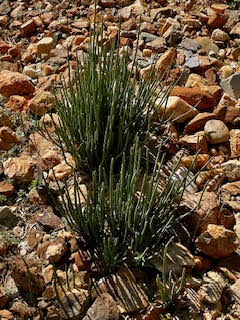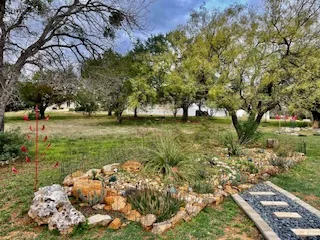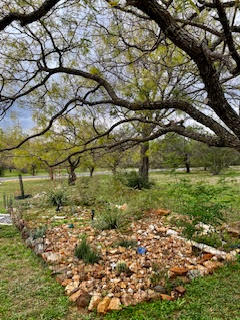Candle Plant, Yerba, or Wax Plant

In 1941, John Whitaker wrote in Nature Magazine that ‘Candelilla has more uses than any other
product originating from an uncultivated plant on this continent.’ I had no idea that this unassuming
succulent had such a long and interesting history. After doing a very deep dive into this plant, I was
hooked. There is a fabulous web site full of fantastic information and history on ‘Little Candle’ at
www.texasbeyondhistory.net/wax camps. In 1829 the botanist J.G. Zuccarini first mentioned this plant
that was sold as a medicinal tea. (Euphorbia antisyphilitica) received it’s species name due to the white
sap used historically in Mexico to treat sexually-transmitted diseases. Being in the genus Euphorbia, the
latex sap can cause discomfort if touched. We here in Texas are familiar with many Euphorbias used in
pots and cacti/succulent gardens:
E. tirucalli-‘Pencil Cactus’ or ‘Milk Brush’
E. rigida-‘Gopher Plant’
E. pulcherrima-‘Poinsettia’
E. milii-‘Crown of Thorns’
E. marginata-‘Snow-On-The-Mountain’
E. lomelii-‘Slipper Plant’
The world wide uses of this high quality wax, extracted by boiling, is astounding. In early days the wax
was used for soap, religious statues, artificial flowers, candles, and cloth in Spanish Missions. In the early
1900’s it’s uses became more commercial; water proofing compounds, paint varnish, floor varnish,
lipsticks and balms, a food additive, car wax, ointments, binders for carbon paper, inks, crayons, hair
conditioner, and coating thread. During World War 1 in the early 1920’s there was a ‘Great Wax Rush’ to
waterproof tents and ammunition. Also used by General Pershing in 1916 while pursuing Pancho Villa. In
the 1970’s the Candelilla Wax King, J.E. Caster, developed Wrigley’s Gum. David Adams from Marathon,
TX was harvesting 60,000lbs. a month to make Beechnut Gum.
The Candle Plant is rhizomatous and can spread into 6’ wide clumps in the desert. When it gets that
large, the center will die out, so it takes on a donut shape. Rabbits tend to make their nests in the donut
hole. It is very grassy looking and multi stemmed with a grey/green color. As with all succulents, the wax
gets thicker in times of drought to protect the plant from drying out. When the rains finally come, it
plumps up, and creamy white flowers appear with red centers. The tiny leaves appear only on new
growth and soon fall off. It is dioecious meaning having two distinct sexes, and it has many male flowers
surrounding one single female. It should be divided every 3-5 years and can also spread with seeds. It is
mostly found growing freely in the Trans-Pecos area of Texas, Mexico, New Mexico and along the Rio
Grande River. Candelilla is very heat resistant and the hardest wax available. It rarely dies in the desert
and will last a long time after being dug up, like most succulents. It usually takes 2-5 years to produce
significant wax to harvest.
Itinerant workers have found it is best to pull it up by hand or with pitch forks, not using a large
backhoe. Native stands produce the most wax, not wholesale growers. Much of it was harvested illegally
and hauled away on donkeys or mules. Many thousands of pounds were taken out of Big Bend National
Park which is now illegal. There is even a small town called Candelaria in West Texas near Alpine and
Lajitas. The whole process of producing the wax is very labor intense and an involved process. The plant
is dug up by hand and laid in large piles to await processing. Large vats are dug into the ground with
room for a fire to be lit underneath. The plant stems are loaded into the vat and immersed in sulphuric
acid. There is a heavy grate laid on top to keep the stems from rising up out of the vat. As it heats up to a
boil, the wax foam floats to the top where it is skimmed off by a espumador. The leftover plant stems are then laid out to dry in the sun and used as fodder to heat the next patch. The foam dries into yellow
cerote, much like heavy cream. Then it is loaded into barrels with another long process of refining. It is
boiled again to let the dirty sediment float to the bottom and the remaining wax is said to smell like
beeswax.
When we built our current house five years ago, a waste dumpster was placed on the far side of our
lot. Once removed, we were left with TX red dirt, sand, small chips of limestone, and decomposed
granite. What would grow well in that spot I wondered? A cactus and succulent garden! It’s 20’-26’ and
filled with Agaves, Cacti, Aloes, Bear Grass, Hechtias, Dyckias, Pride of Barbados, a Golden Barrel Cactus,
and of course, Candelillia. It is best to place it towards the front of the bed since it never gets much over
26” tall. It is cold tolerant to about 25 degrees and then I cover it with towels. It is listed for Zones 8-11
and has no real pests. It likes alkaline, rocky soils and can survive with reflected sunlight. Mine happens
to be under a large Mesquite Tree. Great for a hell strip and needs little water once established. And it is
visited by butterflies when in bloom. One of it’s best qualities is the deer don’t like it! I recently saw on
Etsy that a one gallon can be purchased for $29.99. The Nectar Bar in San Antonio sells it for $45 in a 3
gallon container. The Natural Gardener also has it for sale with a great selection of succulents and cacti.
Try it out- makes a wonderful addition to any desert garden. For an added treat, my Corn and Opium
Poppies love to grow amongst the rocks in my cactus garden and make a colorful spring addition to all
the greenery.



